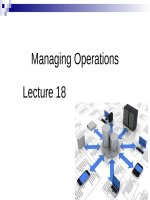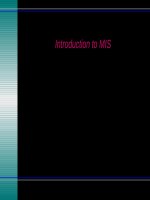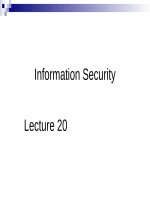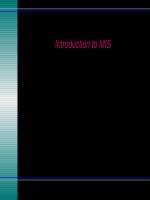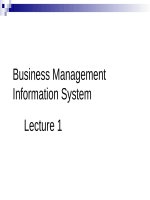Lecture Business management information system - Lecture 17: Managing information
Bạn đang xem bản rút gọn của tài liệu. Xem và tải ngay bản đầy đủ của tài liệu tại đây (9.15 MB, 60 trang )
Managing Information
Lecture 17
Today’s Lecture
n
We will cover today,
Managing Information and types of
information
¨ Data Warehouses and Managing Data
Warehouses
¨ Document Management
¨ Content Management
¨ Case Studies
¨
Managing Information
n
Once enterprises get their data into shape, that data
can more easily be turned into information
“Information is power.”
“We are in the Information Age.”
n
These and similar statements would lead you to believe
that managing information is a key corporate activity
Managing Information
n
¨
Technology = infrastructure;
¨
Asset = information that runs on that infrastructure
It also raises a number of management issues
Managing Information
Four Types of Information
n
In Figure 7-3 we looked at a matrix representing the full
scope of data information resources:
n Internal record-based information, such as those
found in databases
¨ Which we discussed in detail but there are
others:
§ Internal document-based information, such
as reports, opinions, e-mails and proposals.
Pertains to concepts: ideas, thoughts, etc.
§ External/record-based information, such as
acquisition from external databases.
§ External/document-based: WWW
Managing Information
Four Types of Information cont.
n
Internal record-based information was the original focus
of IS departments because it is the type of information
that computer applications generate and manage easily
n
External record-based = accessible via Internet or public
databases
¨
Including subscription
Managing Information
Four Types of Information cont.
n
n
Until recently = little attention to internal and external
document-based information because it was so difficult
to manipulate in computers
¨ Intranets changed this
¨ Documents = integral part of information on these
sites
n Responsibility = now on IS, even if just for
technical issues
Four areas were responsibility of different areas but now
IS is likely to be involved in some way
Managing Information
Data Warehouses
n
n
Data warehouse: Houses data used to make decisions
¨
This data is obtained periodically from transaction
databases
¨
The warehouse provides a snapshot of a situation at
a specific time
Data warehouses differ from operational databases in
that they do not house data used to process daily
transactions
¨
Operational databases have the latest data
Managing Information
Data Warehouses
n
¨
Data warehouses = not so ‘time critical’
¨
Like ERP systems, they, too, spurred getting recordbased data into shape
The most common data warehoused are customer data,
used to discover how to more effectively market to
current customers as well as non-customers with the
same characteristics
Managing Information
Data Warehouses cont.
n
n
The simplest (MIS) tools generate perforated reports or
permit ad hoc queries
Warehouses are reaching beyond reporting internal
data
¨
They are being combined with purchased data,
such as demographic data, late breaking news and
even weather reports, to uncover trends or
correlations that competitors might not spot
¨
To give a company a competitive edge
Managing Information
Data Warehouses cont.
Key Concepts:
n
Metadata: The part of the warehouse that defines the
data. Metadata means “data about data.”
¨
Metadata explains the meaning of each data element,
how each element relates to each other, etc.
¨
It sets the standard – without it data from different
legacy systems cannot be reconciled, so the data will
not be “clean”
Managing Information
Data Warehouses cont.
n
Quality data: Is the cleaning process to adhere to
metadata standards
¨
n
The older the data the more suspect its quality
Data marts: Is a subset of data pulled off the warehouse
for a specific group of users
¨
In the early 1990s, one huge warehouse was
envisaged, but proved un-practical due to long search
times and large cost factors
Managing Information
Data Warehouses cont.
5 Steps in a Data Warehousing Project:
1.
Define the business uses of the data
2.
Create the data model for the warehouse
n
i.e. defining the relationships between the data
elements
5.
Cleanse the data
6.
Select the user tools
n
Consider the users point of view by selecting the
tools they will use & then training them on tool
use
7.
Monitor usage and system performance
Managing Information
Data Warehouses cont.
n
Data warehouses are seen as strategic assets that can
yield new insights into customer behavior, internal
operations, product mixes and the like
n
But to gain the benefits, companies must take the step
of reconciling data from numerous legacy systems
¨
= Make sure the data is ‘right’
OWENS & MINOR
Case Example: Data Warehousing
n
Illustrates numerous ways O&M are using its data for
competitive advantage
n
Includes us of
¨
ERP
¨
Data warehousing
¨
Web
OWENS & MINOR
Case Example: Data Warehousing
n
Not only for internal use but as the basis for new
revenue-generating services to customers and
suppliers
n
Shows how innovative companies can use advanced
information management technologies
OWENS & MINOR
Case Example: Data Warehousing cont.
n
n
This distributor of name-brand medical and surgical
supplies uses ERP, data warehousing, and the Web
¨
Not only for internal use of data
¨
But as the basis for new revenue-generating
services to customers and suppliers
It is using its data for competitive advantage
¨
It augmented its ERP system to automate order
forecasting, which:
§
Improved inventory turns
§
Lowered ordering rates from five-times-a-week to
once-a-week, and
§
Improved customer service
OWENS & MINOR
Case Example: Data Warehousing cont.
¨
It implemented an Internet-based inventory
management system so that customers could order
over the Internet, even using handheld devices
¨
It even offered access to its data warehouse and
decision support software to customers and
suppliers who use the data to run their businesses
OWENS & MINOR
Case Example: Data Warehousing cont.
n
Delivering this information over the Web has:
¨
¨
¨
Strengthened its relationships with trading partners
Given it a market-leading feature to entice new
customers, and
Turned the data warehouse into a new source of
revenue
OWENS & MINOR
Case Example: Data Warehousing cont.
n
When the system was rolled out, it was the first “ebusiness intelligence application” in the medical and
surgical supply distribution industry
n
As a result, O&M has become an important
“infomediary” in its industry
Managing Information
Document Management
n
n
n
Even in today’s Internet-rich world, paper still plays a
major role in most enterprises
There is also a need to move seamlessly between digital
and printed versions of documents; hence, the
importance of document management
The field of electronic document management (EDM)
uses new technologies to manage information resources
that do not fit easily into traditional databases
Managing Information
Document Management
n
EDM addresses organizing and managing conceptual,
descriptive, and ambiguous multimedia content.
n
Applying technology to process traditional documents
makes a major change in what documents can
accomplish in organizations
